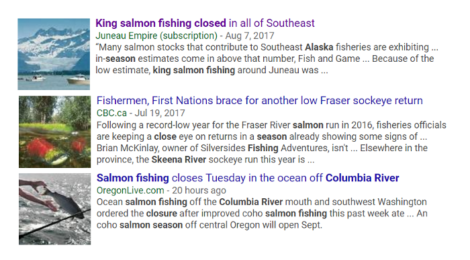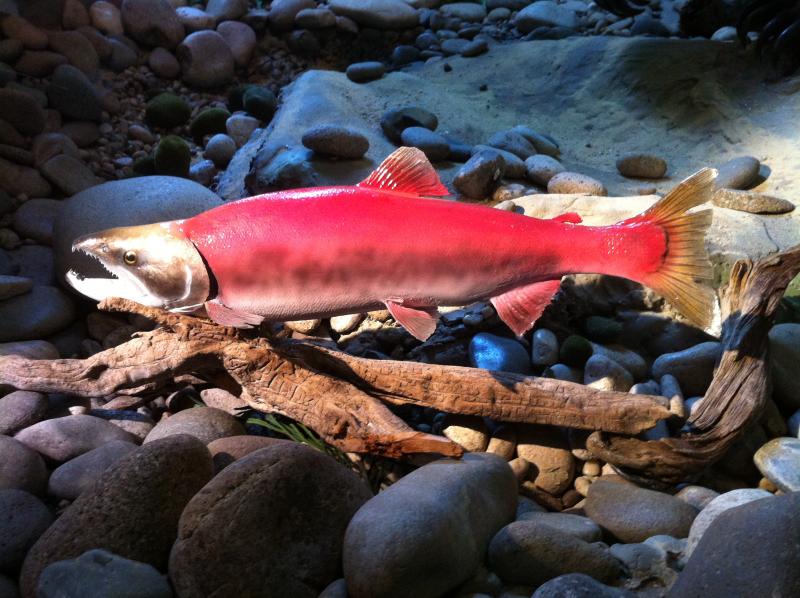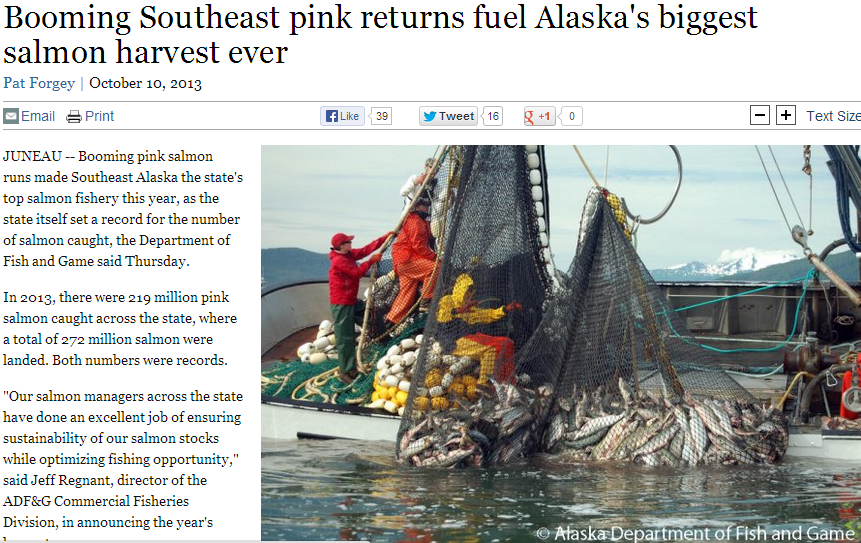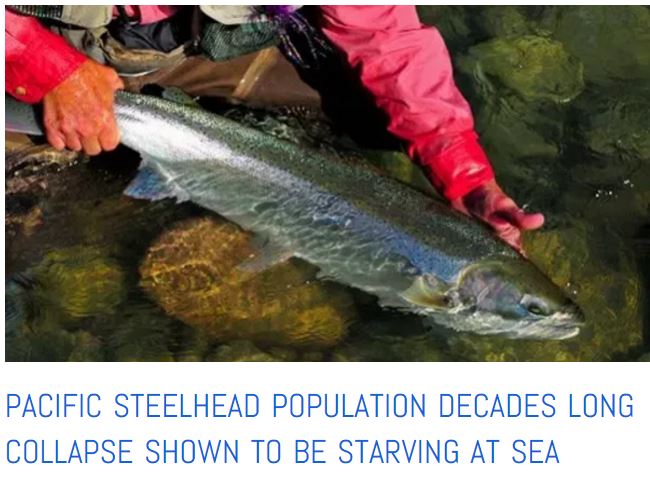
What’s It Gonna Take To Save The Salmon As Alaska Shuts Down Big Salmon Fishery
Alaska shuts down all King Salmon harvest in southeast region due to ‘poor ocean survival conditions’
In Oregon the headline reads, ‘Steelhead struggling home in record low numbers’ and ‘Fish and Game stops fall steelhead harvest’
In neighbouring Canada the headline reads, ‘We haven’t even had a full week’: fisheries workers in Prince Rupert struggling to make ends meet as low salmon returns and shutdown of canning operations create bleak outlook for industry.’
Everywhere the story is the same, salmon biologists of whom 99 out of every 100 work in fresh water lay the blame for the disappearing salmon on their failure to survive at sea, aka they are starving at sea as ocean salmon pastures become clear blue lifeless deserts.
It’s time to restore ocean salmon pastures and bring back the fish before it is truly too late.
The Alaska Department of Fish & Game shut down all commercial and sport-fishing harvest of king salmon in southeast Alaska last week because of “poor ocean survival conditions for Chinook (king) salmon.
The department said in a news release that extreme management measures were necessary to restrict harvests in coastwide fisheries that are directed at stocks originating in southeast Alaska, northern British Columbia, the Fraser River and the Washington coast. The agency said poor conditions are expected to persist through at least 2018.
This will affect not only commercial angling but also recreational fishing. Though anglers may still catch the fish in some areas, they won’t be allowed to keep them.
The department said many of the salmon stocks that contribute to southeast Alaska fisheries are experiencing record-low production.
In Idaho where many salmon try to end up to spawn once they have made it up the Columbia River the picture is dismal.
An extremely small number of steelhead returning to Idaho so far has prompted the Idaho Department of Fish and Game to close all rivers to harvest for the fall season, beginning Aug. 17. Catch-and-release fishing remains open.
Since 1987, all wild fish have been required to be returned to the river. This year, due to the low numbers, hatchery fish must also be returned. Steelhead season on the Salmon River is normally Sept. 1 to April 30, three per day, nine in possession, with a catch-and-release season Aug. 1-31.
The department stated in a press release that through Aug. 14, about 400 steelhead crossed Lower Granite Dam on the Snake River, about 30 miles downstream from Lewiston—a small fraction of the 10-year average of about 6,000. The thousands of fish now missing never made it back from their ocean feeding pastures into the Columbia River, they simply are starving at sea.
To the north in British Columbia the fishing industry is torpedoed by the lack of fish.
“There’s not a lot of fish,” said Karen Morgan, a tally person at Canfisco the big fish processor in Prince Rupert.
“There used to be an abundance of pinks. We never thought they would go away, and they’re going away. And there’s hardly any sockeye at all.”
Fraser River sockeye fishery closed after the lowest early returns in history. Skeena River sockeye returns are similarly showing to being the worst on record.
The Columbia River Sockeye are in a terrible collapse
Canadian government and native tribal authorities report the sockeye salmon numbers entering the Osoyoos system a tributary to the Columbia River are down dramatically, the announcement has been made,
“there will not be a recreational or commercial sockeye fishery on Osoyoos Lake this year.”

25 years ago this soil male Sockeye Salmon made it up the 900 miles of the Columbia River to the lake named for his kind, Redfish Lake. The fish was preserved and named “Lonesome Larry” with more than 95% of the Columbia River Sockeye now accounted for just two Lonesome Larry’s, yes two males, have made it to Redfish Lake in the mountains of Idaho. If no lady Sockeye make it the authorities will fly some in to keep the two Larry’s from dying unfullfilled.
So far, barely 40,000 sockeye have been recorded at Wells Dam at the confluence of the Columbia and Okanogan rivers in Washington State – the last major dam before the fish make their ascent to Osoyoos Lake.
In the recent history making year of 2014 more than half a million Sockeye made it into the lake. More than 200,000 of those fish went to feed the native people of the region.
.
Both the starving at sea problem and the solution are now well proven.
The ocean salmon pastures are in a continuing state of collapse as evidenced by both the scarcity of the salmon again this year and by the abundance seen in many stocks in the years following a remarkable effort in 2012 when the North Pacific salmon pastures were intentionally and effectively restored bringing record catches of salmon into the nets and onto the plates of people from Alaska to Oregon.
The 2014 banner year for Sockeye salmon in Lake Osoyoos was no accident on Nature. It was the direct result of a long and carefully pilot project to prove that ocean fish pastures that are dying and becoming ever clearer, bluer, lifeless deserts can be immediately restored to historic health and abundance. That work was done by me, in a project developed with the participation of the Canadian federal government via its National Research Council, Ministry of Indian and Northern Affairs, National Science and Engineering Research Council, Canadian Space Agency, the Canadian Science and Economic Development organization and many other ministries of the federal and provincial government as well as international science and industry development agencies.
But the return of ten times the number of Columbia River Sockeye salmon to Osoyoos Lake precisely as was expected was just a small part of the story. The big fish story took place in Alaska in the very region struggling now with emergency orders closing down salmon fisheries. In 2013 precisely in perfect timing with the restoration of the Alaska Pink Salmon pasture, which just happens to be shared as the Southern Sockeye pasture the fish came back in staggering numbers.

My 2012 ocean pasture replenishment and restoration work in the NE Pacific returned the ocean to life as seen in the largest catch of salmon in all of history in Alaska the next year. Click to read more
A great tragedy of this story is that the almost exclusive whiteman’s salmon science cabal could not, and to this day, will not stomach any salmon science that comes from outside their tightly defended cliques. After all their salmon biology business is BIG business. In the Columbia River system alone over the past 20 years $16 billion dollars has been lavished on so called salmon programs that were supposed to but have utterly failed to bring back the fish.
That a tiny native people village and one ‘out of the box’ ocean ecologist (me) might Bring Back The Fish in historic health and abundance over in thousands of miles of rivers and streams for a mere few million dollars in private money has been met with absolute horror by the Salmon Environmental Industrial Complex. Just where those $16 billions went, and that’s just a fraction of the whole, no one can really say, or shall we say the ‘accounting is nothing short of fishy.’
The pundits may pose a billion reasons why there is no better, faster, cheaper way to BRING BACK THE FISH but the fish have spoken and hundreds of millions of salmon can’t be wrong. Indeed dust for the oceans bring back the fish whether that dusting comes from natural volcanoes or with the good intentions good shepherding of the ocean pastures by the hand of man.
Alas the tiny village project was destroyed by the evil cabal and that too is a fact and today the salmon are missing and shown to be returning to our rivers and streams in the lowest numbers in all of history.
You can read everywhere on this blog the full story of the the hope, the horror, and still the hope that we can and so we must Bring Back The Fish. Join Me.









